Qinling Mountains Trip Report, 2005
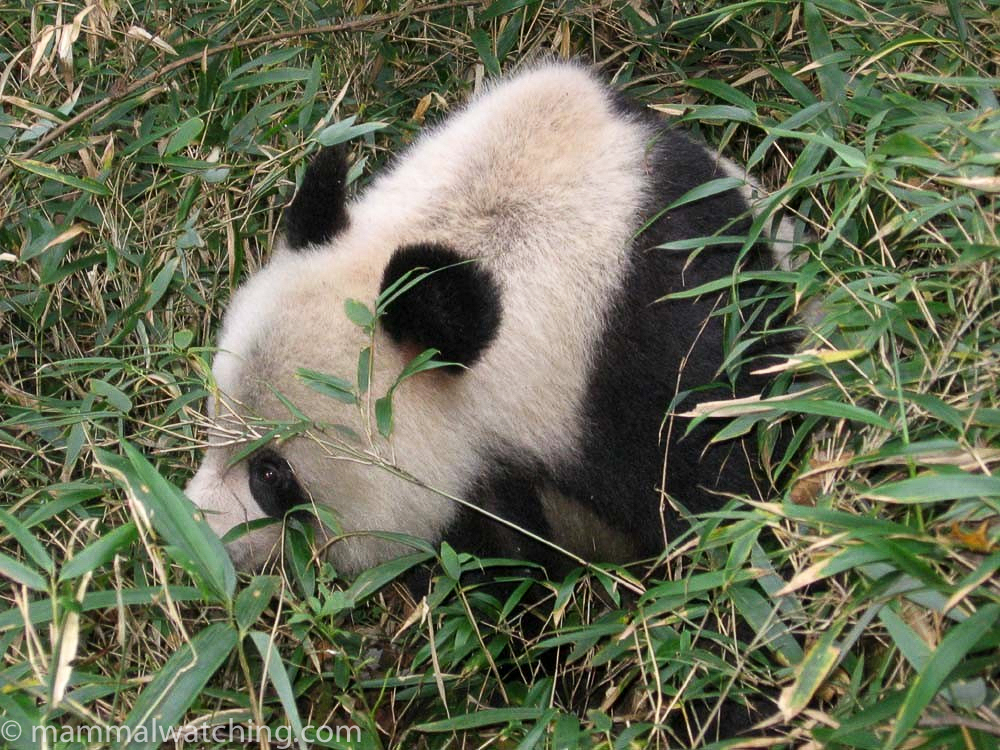
Giant Panda, Ailuropoda melanoleuca
My first trip to China in October 2005 remains a highlight of my travels. I stopped en route from Australia to a new job in Paris. I’d been so swept up in organising the move that I’d had little time to think about the trip. I didn’t know of anyone who had seen a Giant Panda and thought I had only a slim chance, But I thought it would be fun to try.
Unfortunately Giant Panda watching was a fairly short-lived adventure and was shut down a few years later after a backlash from the Chinese public (more information on why is here).
The following runs through my trip and the mammals. I’ve included a few italicised entries from my diary that try to capture the feel of the place.
I organized the trip through www.wildgiantpanda.com. So far as I could work out they had begun organizing trips to these mountains a few months before I visited as a part of a WWF funded ecotourism project in the Foping Nature Reserve. The company was professional and I’ve no hesitation in recommending them (though I’m not sure if you have much choice if you want to visit the Qinling Mountains). They were immensely helpful beforehand. Zoe Zuo, who I dealt with, speaks excellent English and was always quick to reply to my emails.
The Qinling Mountains are near the city of Yangling. I flew into Xi’An (home of the Terracotta Warriors and quite well served by flights). I was whisked away by the waiting panda team (a driver, an organizer and a translator) to spend the night in the Garden Hotel at Yangling, about an hour and a half’s drive. A non-descript hotel in a non-descript city but comfortable enough. I was the only Westerner there.
We set off early for the mountains the next day. It usually takes about 3 hours to drive to the top of the mountain pass. This is the end of the road, from where you must walk along a mule track the last 8km to the Sanguanmiao Research Station, in the heart of Panda habitat and the Foping Nature Reserve. I say ‘usually’ because recent heavy rains had washed the road away lower down the mountain and we had to walk 24km into the station.

The drive up the mountains was pretty hairy. We hugged the edge of a river gorge that wound its way through fairy-tale mountains. The sorts of mountains we’d draw as kids, but covered in every shade of green forest you can imagine, splashed with the reds and golds of the gathering autumn. Sometimes the road was 100 m above the river, sometimes alongside it, but whatever the scale of the drop our fearless driver had no hesitation about overtaking around blind bends. This wasn’t dangerous though because he used his horn a lot. In China most driving is done by the horn.
The road was pockmarked with landslips and rain damage. Every so often we’d come on a group of labourers working assiduously on the smallest hole on their stretch of road, while ignoring the gaping chasm 500 m away. They were dressed far better than I ever am (OK, that’s not saying a great deal), and each wore a lacquered lattice hat as they worked with pickaxes or carrying boulders strung from wooden poles, which they transported like sedan chair bearers.
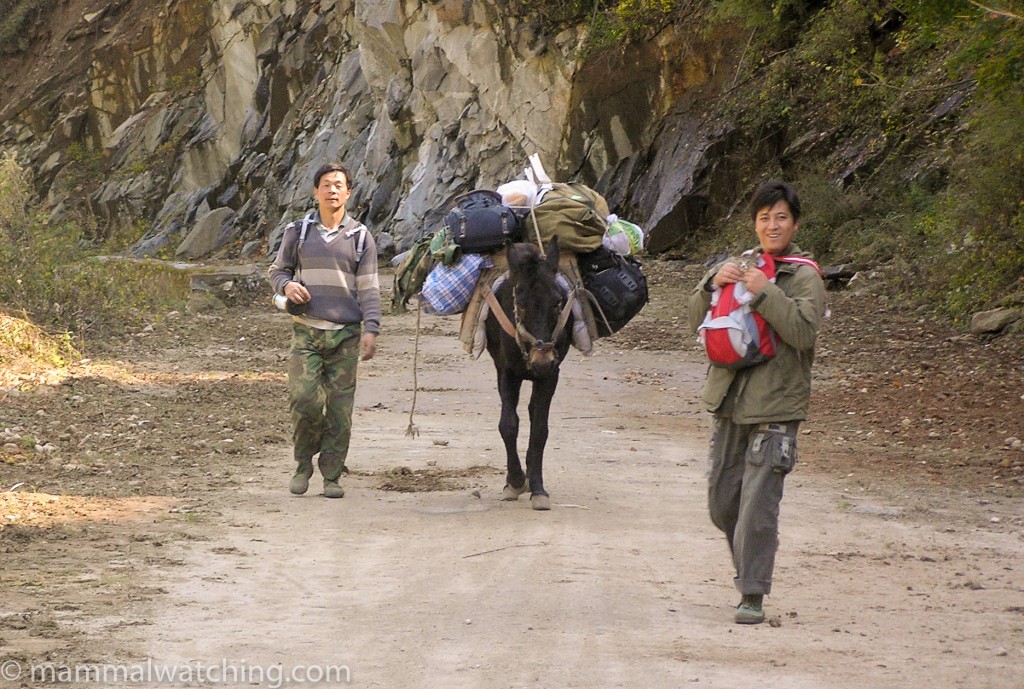
The road to Sanguanmiao Station
We were met at eleven o clock by a very tolerant mule, and Mr Zhang, one of the two panda trackers. He’d just walked the 24km to meet us and promptly turned around to head the 24km back, loaded down with our luggage (including about 40kgs of my mammal traps, spotlight batteries and assorted paraphernalia).
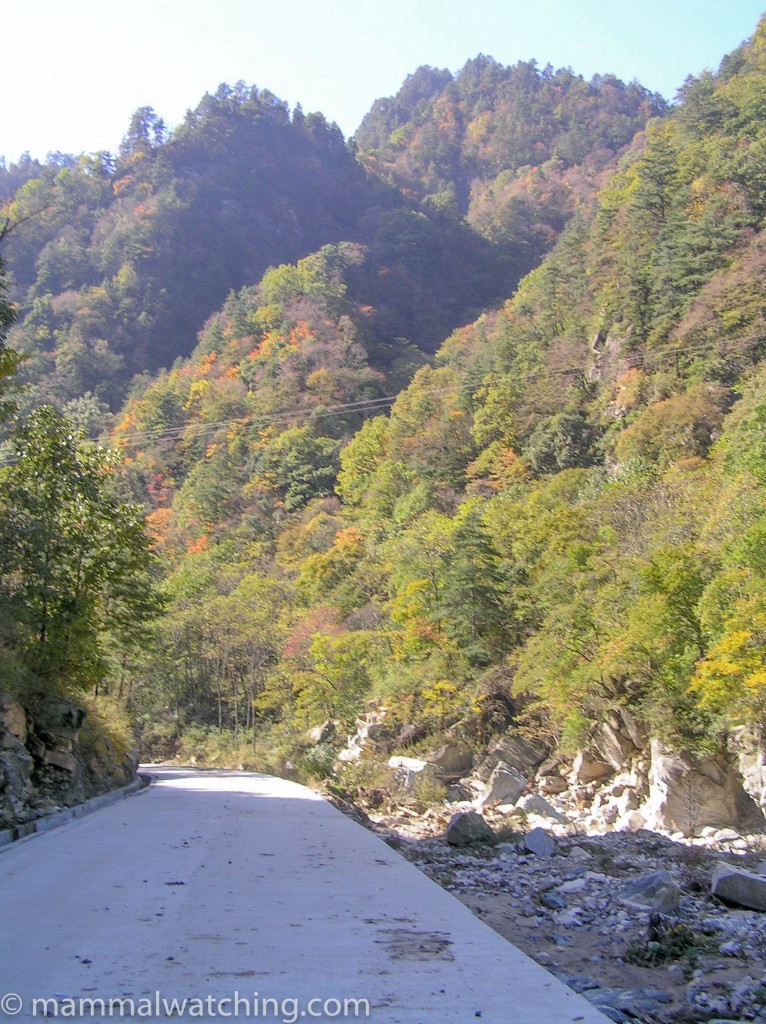
The walk in was easier than I’d imagined. For starters we weren’t wading through a flood. A beautiful late autumn day. The weather was fabulous, 20 degrees in the sun, 15 in the shade. The sky cloudless and the mountain forests, on the turn from green to gold were preposterously beautiful. So we climbed the gradual 15km to lunch at a rest station. I was delighted to hear rumours that a motorbike might be able to ferry us the next 2 steep km up the mountain and even more delighted when the bike appeared. So we grabbed a ride on the back for a couple of kms after lunch, up and over the steepest part of the mountain.
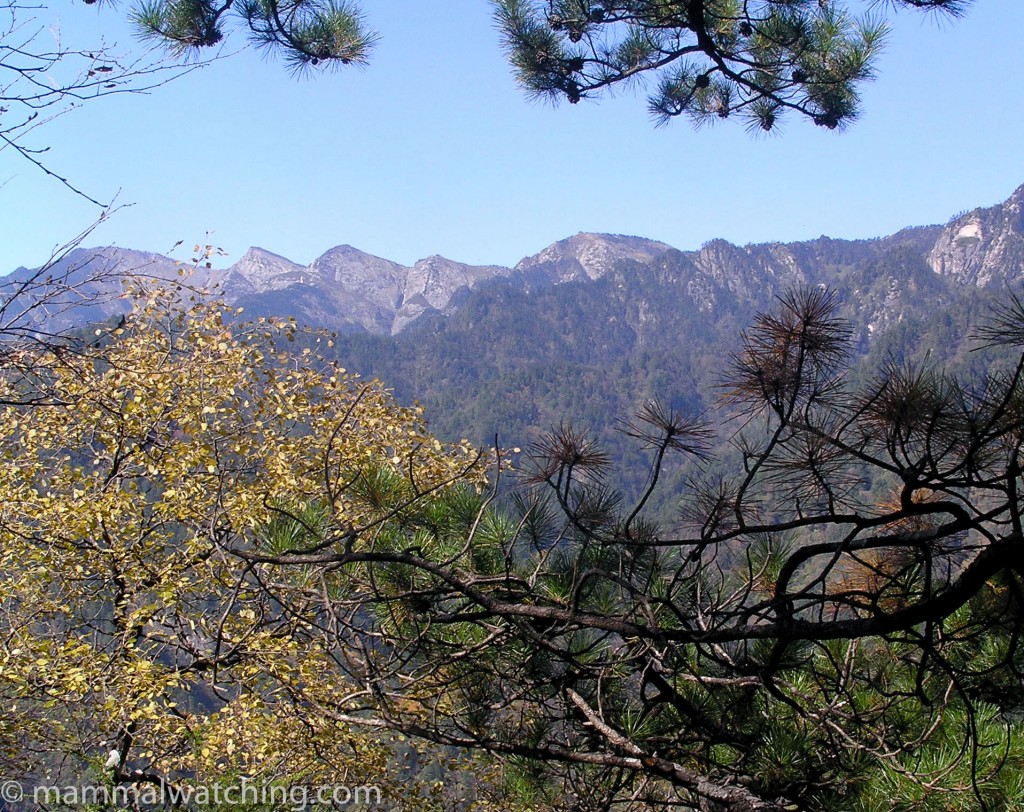
The Qinling Mountains
The only mammals we saw were a couple of Pere David’s Rock Squirrels foraging along the edge of the river (on the rocks surprisingly enough) near one of the rest stops about 4km from the Sanguanmiao.
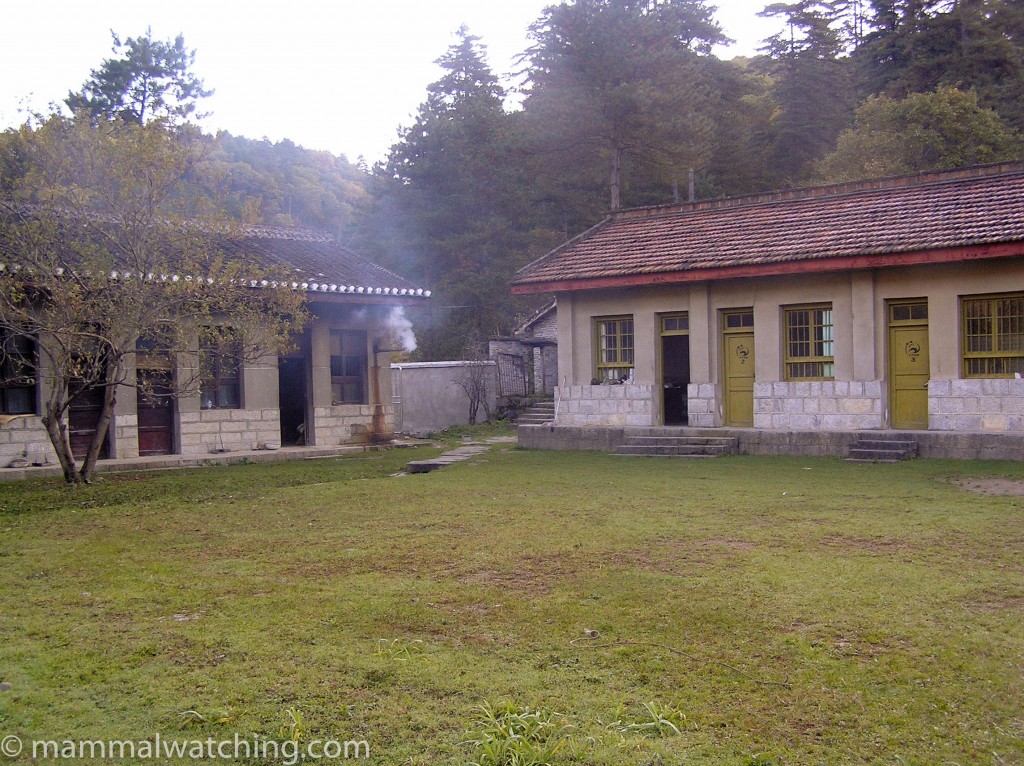
Sanguanmiao Research Station
Sanguanmiao Station is nestled in the heart of the mountains. A pretty basic sort of a place, with half a dozen spartan concrete rooms (a bed, a desk and a bare bulb) and a kitchen/dining room. The generator runs each evening for 3 hours. The food was fairly simple but tasty, so long as you like chillis. It came in good quantity. The “toilet” was an open, communal, ditch.
Though the buildings are ugly the outlook is stunning. A dozen jagged peaks surround us and there wasn’t a breath of wind when we arrived in the almost light of dusk. A couple of horses were grazing in the courtyard and several dogs barked an arrival. Wood smoke drifted out of horizontal pipes by the kitchen and the air was full of the sounds old friends make on reunion.
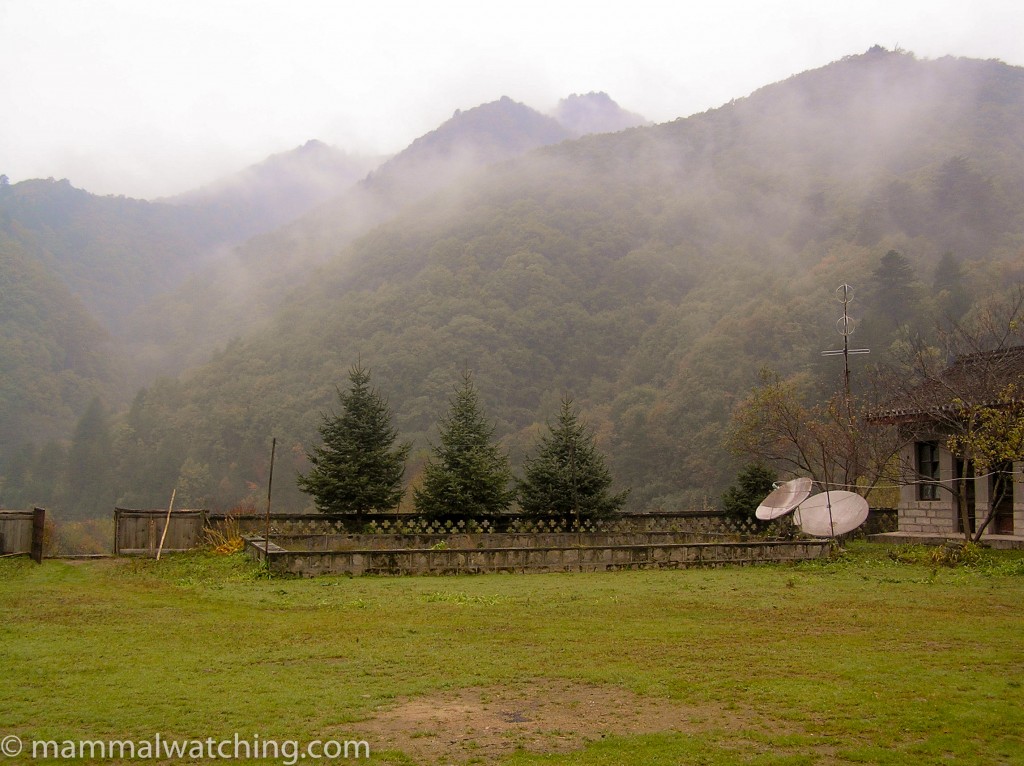
Sanguanmiao Station
We spent each day hiking up and down various mountains. I was accompanied by two local guides – Mr Zhang and Mr He – who had but one word of English between them: “Panda”. They were remarkably good at finding wildlife and at knowing how to get close to it.
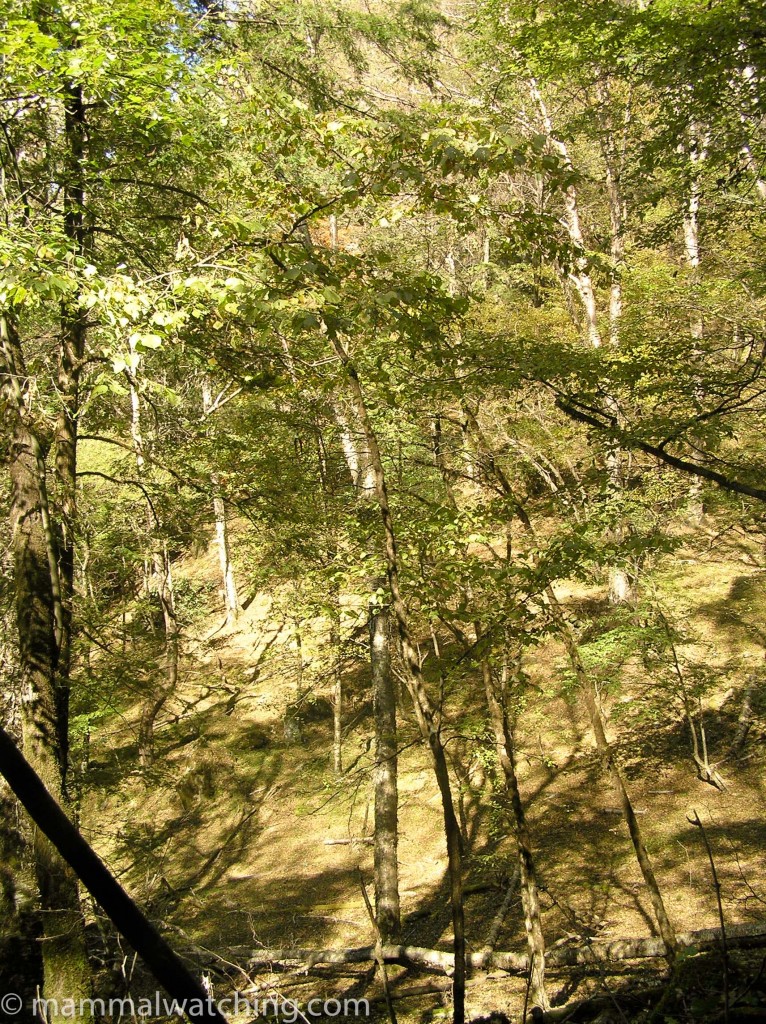
Foping Forest
The usual schedule had us leaving at 9 a.m. and back in camp about 4 p.m., weather permitting. The mountains are pristine. There are no trails so most of the walks into the forest were alongside or inside small creek lines. After that we’d just head up various ridges to get to vantage points. I doubt whether we’d have walked more than 10-15kms on any one day, with plenty of rest stops to listen for animals. But the going was often very steep and quite treacherous.
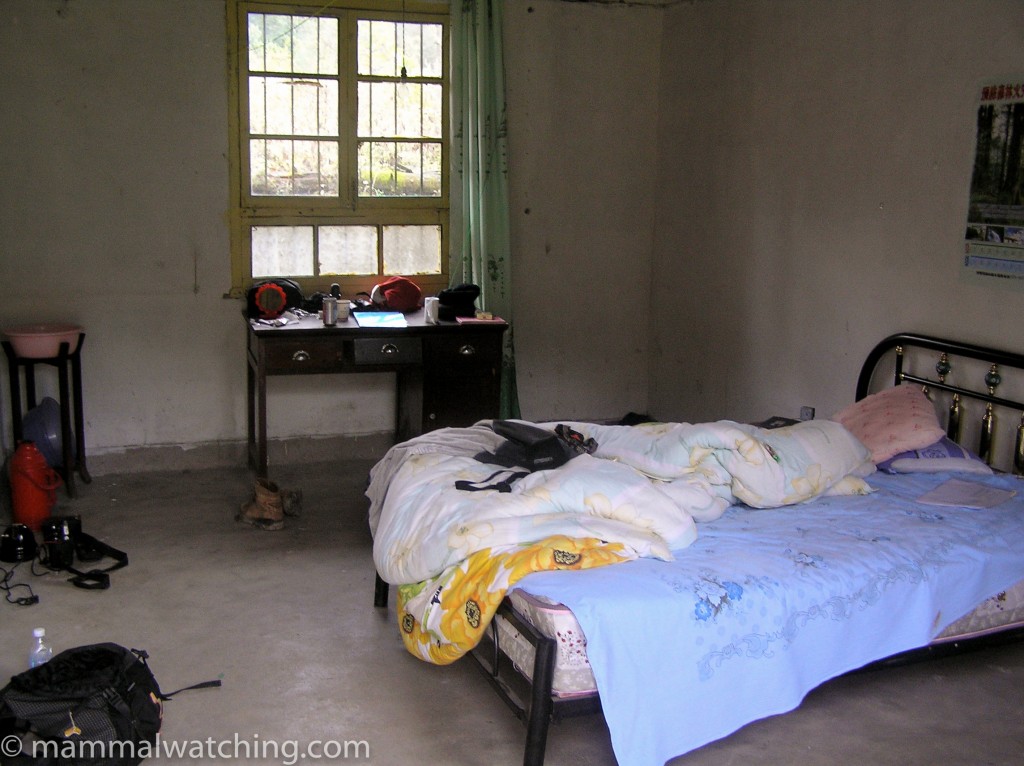
The rooms
The mammal watching exceeded my expectations. I was told I saw a greater diversity of species than most, maybe all, previous visitors (but I bet they say that to all the mammalwatchers). But being alone must have helped, and perhaps I was lucky. Whatever, Mr Zhang organized a feast in my honour one rainy afternoon when our trekking was cut short to celebrate the mammals I had seen.
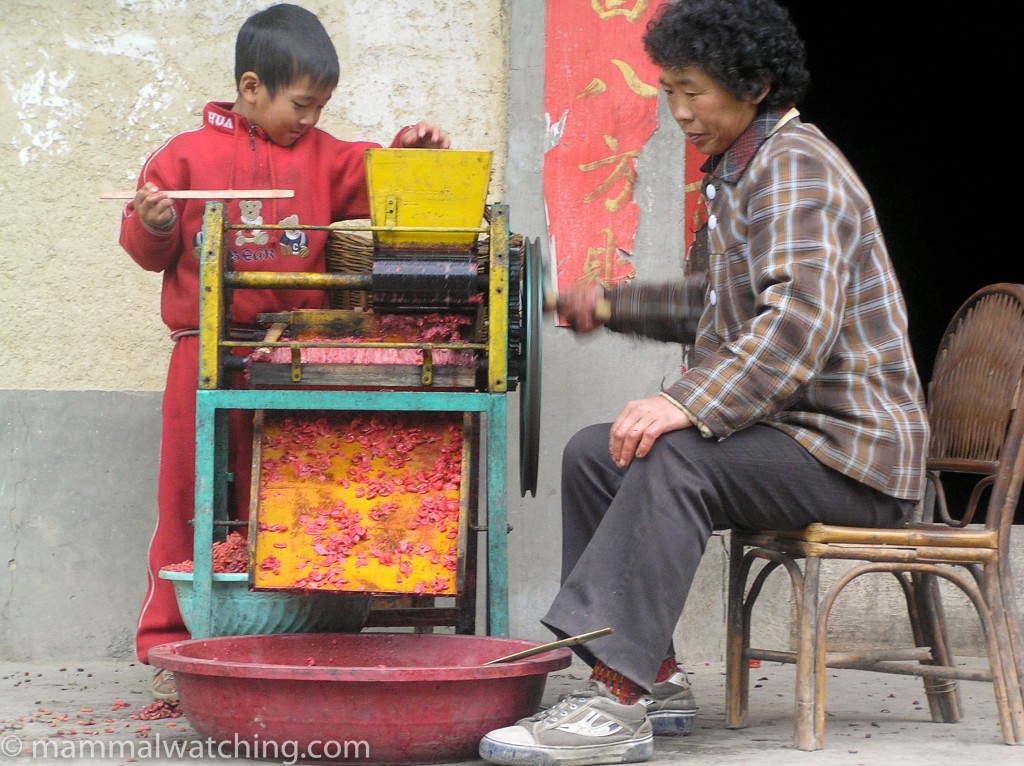
Sunday 16/10
After a couple of hours walking we had a troop of beautiful Golden Snub-nosed Monkeys around us for an hour or so while we perched on the end of a spur.
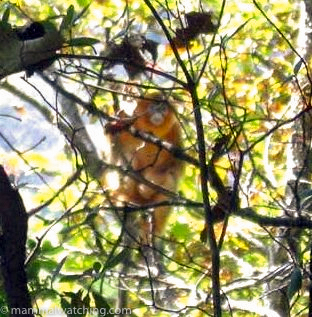
Golden Snub-nosed Monkey, Rhinopithecus roxellana
At the same time we heard Eastern Gray Gorals calling and, once the monkeys had gone, we found a Goral at the bottom of a scree slope for prolonged views. We disturbed another in the forest later that afternoon and came across Panda shit that was only a few days old.
So. I’m sitting here on a log after 6 hours hard going up and down a mountain. I just had a cup of hot water from the thermos flask and either side of me sit the panda trackers in their camouflage gear. The noise of the rushing river is a backdrop to the birdsong and dappled sunlight catches the autumn leaves as they drop.
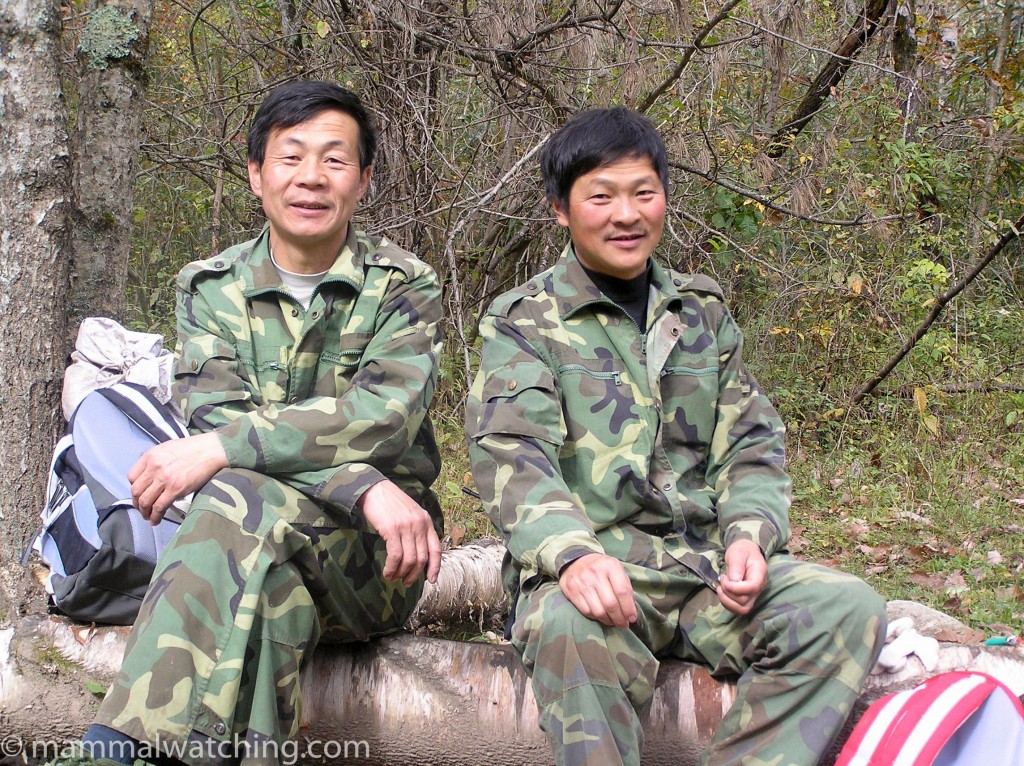
Mssrs Zhang and He
We went for a brief spotlight around the paddock behind the kitchen after dinner. Mr Zhang lives back there so we visited his house and stepped back in time.
We walked into the pitch dark. Mrs Zhang was cooking up something in a wok, the only light from the flame. In the living room Mr Zhang sat next to a candle, turning the handle of a prehistoric mincing machine. The room was 4m square; stone floor and walls. The wooden beams were 3 m above us. In the middle of the room a square had been carved from the stone and it housed a fire. An iron kettle hung from a chain over the fire. The chimney was a short wooden tube that projected down from the ceiling for perhaps 1m. Mr Zhang showed us the fruit he was mashing – some red berries that “made men strong and women beautiful”. Mrs Zhang served us honey and hot water and walnuts from a tray suspended over the fire. The walls of the room were strung with cotton bags that held dried pork. And, amidst this ancient scene, Mr Zhang pulled out his digital camera to show pictures of the monkeys we had seen that morning.
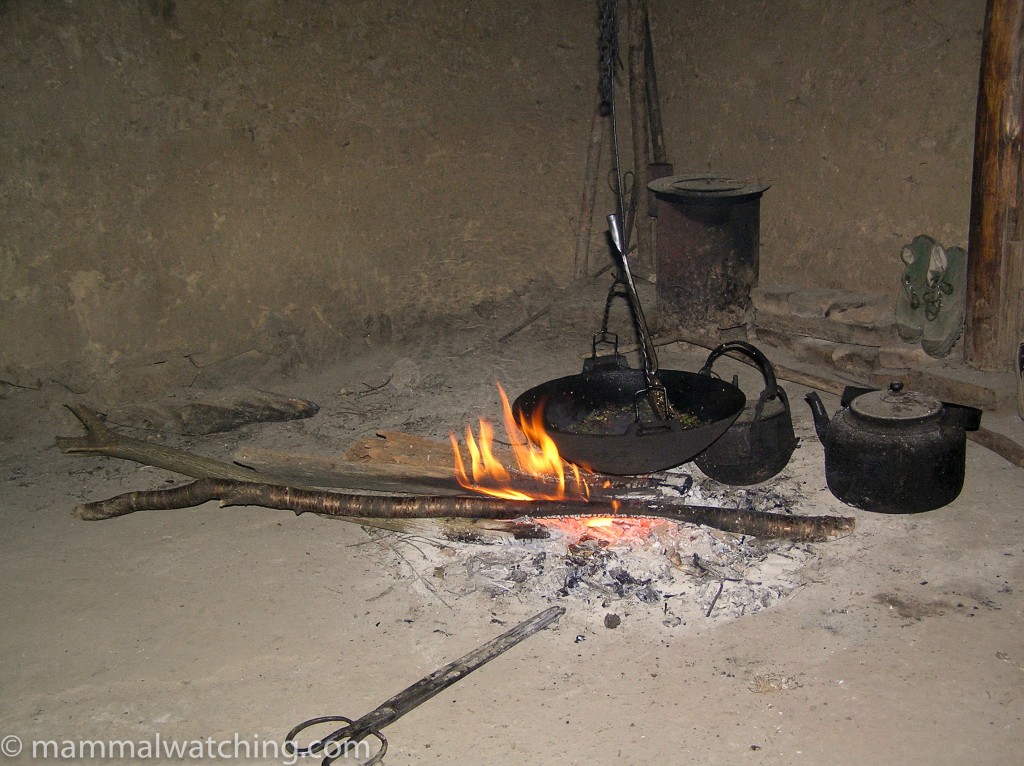
Monday 17/10
Soon after leaving the main trail we saw a young Golden Takin about 10 metres from us. We spent the day looking for Pandas and found very fresh poo, nests, tracks and chewed bamboo. But not the beast itself.
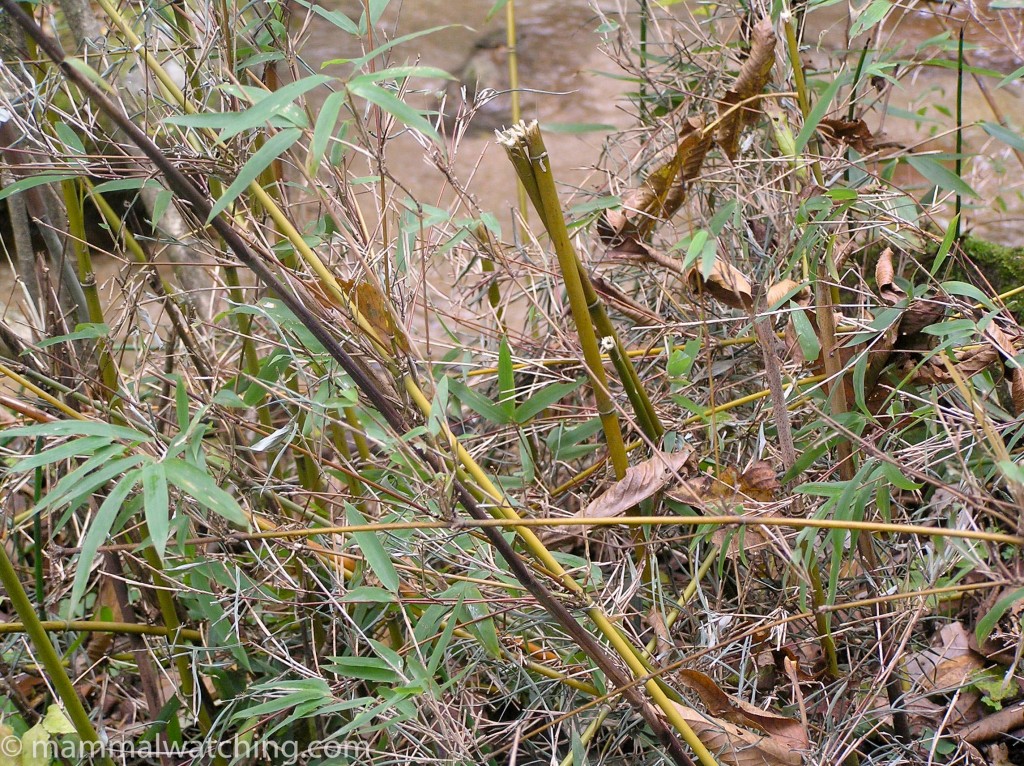
Giant Panda feeding signs
We saw our first Swinhoe’s Striped Tree Squirrel and On the way home we had good, if quite distant, views of three adult Golden Takins. This mountain ox, with a shaggy golden fleece, reaches a whopping 400kg and is nothing short of spectacular.
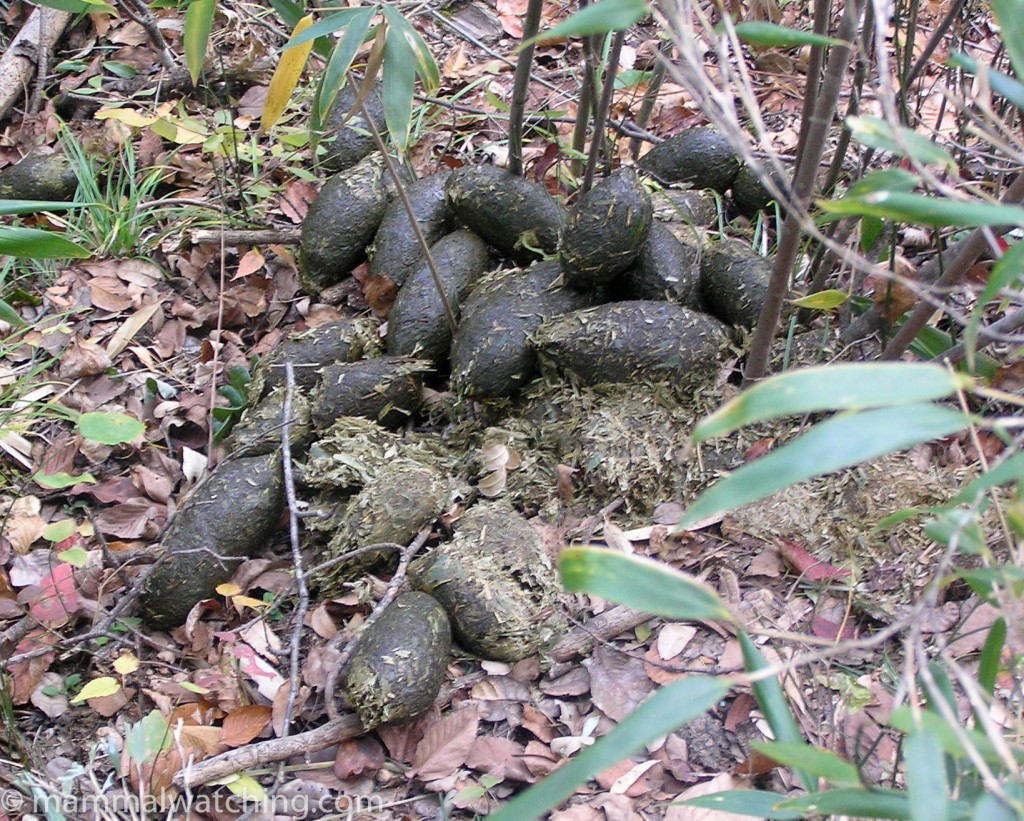
Panda Poo
That evening we visited Mr He’s house where a few people had gathered to drink whisky and eat delicacies.
A couple of times I enquired about the conversation. It could have been taken from any Australian dinner party. One particularly animated segment had the men comparing the virtues of their horses (in Canberra see Holden Commodores versus Ford Falcons). At another point they were discussing what it feels like to be drunk. All very surreal.
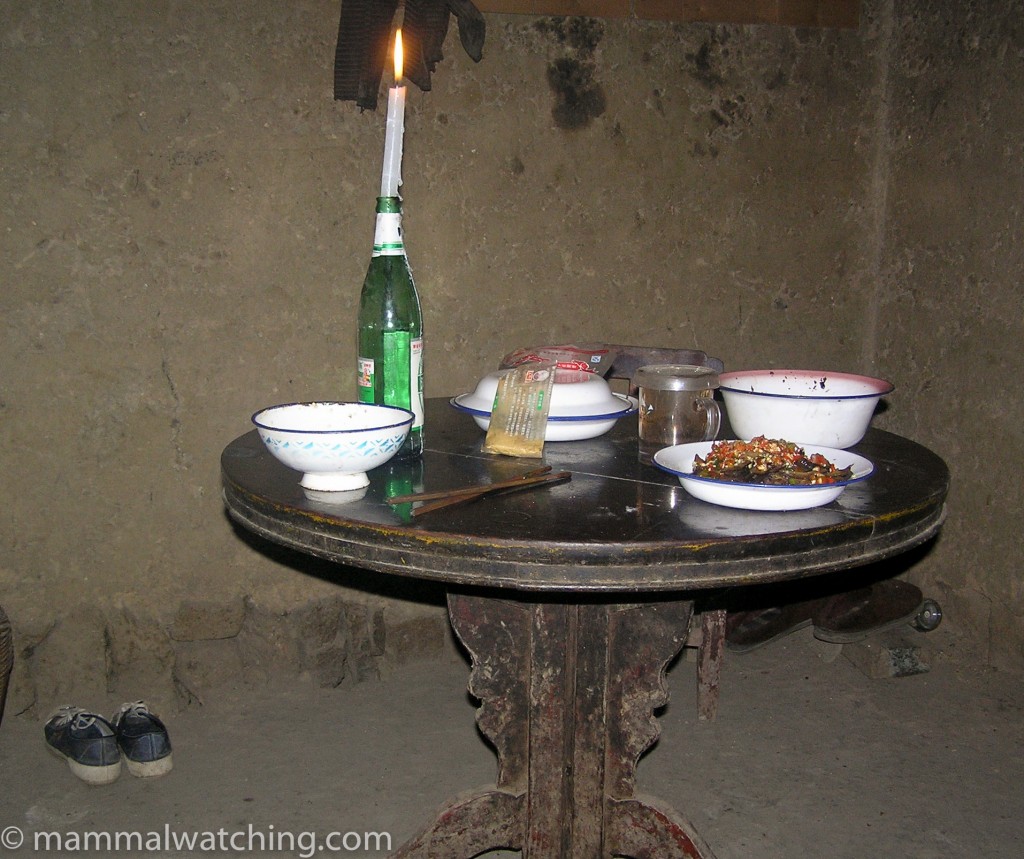
Tuesday 18/10
Today we focused exclusively on finding a Giant Panda and returned to yesterday’s mountain where we’d seen so much fresh field sign. At 1 p.m. we heard an animal moving through the bamboo about 50m beneath us (we were on a ridge line). Mr Zhang whispered “Panda”. I was sceptical given all we’d heard was a rustling. But then the animal called (sounding something like the second syllable of a Donkey’s hee-haw) and Mr Zhang gave me a knowing smile.
We spent the next three hours crawling after the beast as it gradually moved along the mountain side but we didn’t get a glimpse. It wasn’t moving quickly and we had time to move small sticks and leaves out of the way as we painstakingly placed each foot and hand in front of the next. By 3 p.m. the animal had moved further away from us, down the slope, so Mr Zhang hatched Plan B. He and I doubled back to the valley floor while Mr He was to head straight down the slope to flush the animal out. The panda emerged about 10m from Mr Zhang’s vantage point.
I was fidgeting around at my vantage point when Mr Zhang let out a whistle and started urgently flapping his hand. Clearly I was wanted but I wasn’t sure if the flapping meant speed or silence was of the essence. He tends to expect both. I tried to strike a balance but silence won the day. By the time I reached Mr Zhang there was no sign of the Panda though somehow he had taken 4 amazing close up shots. ‘Aghast’ doesnt quite capture it. But he reckoned it was still close by. Sure enough there was a rustling in the bamboo 30 metres away and out it emerged. Black shoulders and grubby white rump. My brain was racing with all the other animals it might be but then it turned to look at me and there was no doubting it. I was very happy even ifI didn’t get a photo. I gave Mr Zhang a hug and pressed my cheek to his. He was as happy as me I think.
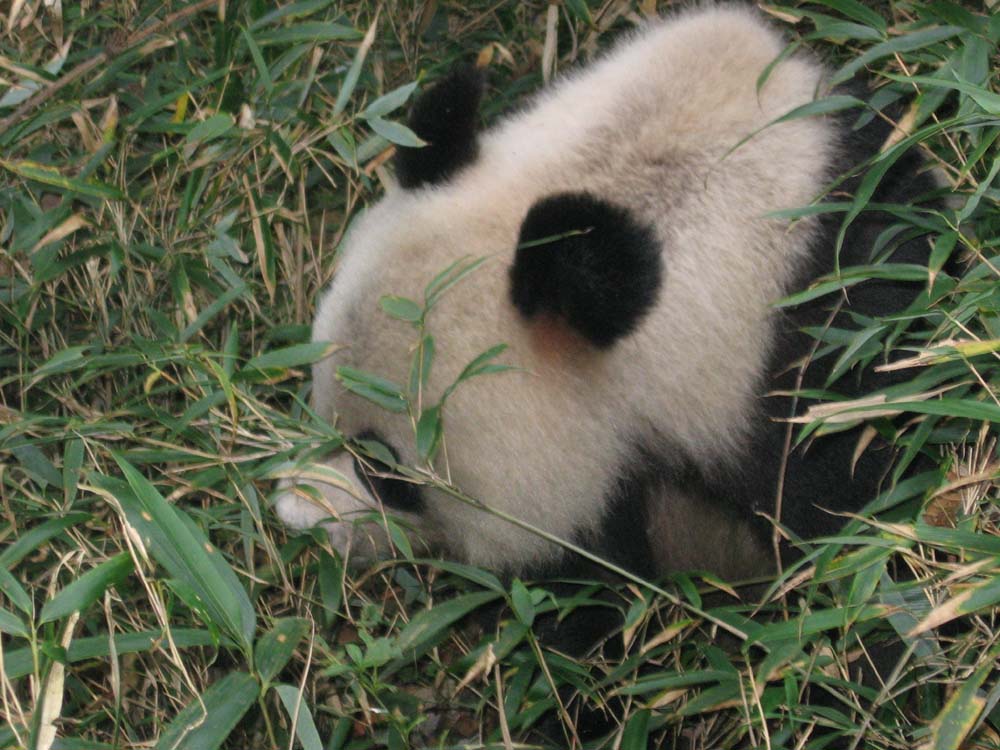
Giant Panda, Ailuropoda melanoleuca: Mr Zhang’s photo; my Panda.
Wednesday 19/10
When I woke up it took me a few seconds to remember I had seen a Panda. And then I felt delighted all over again.
The excellent weather I’d enjoyed to date began to deteriorate and so we stayed closer to camp. We focused on looking for Serows on the closest mountain to the station. But despite finding several latrine sites, the heavy cloud and drizzle hampered us and we were home by 2 p.m. But not before Mssrs Zhang and He beat seven shades of crap out of a hollow tree with a big log to encourage a very large Red and White Giant Flying Squirrel to stick his head out of his hole.
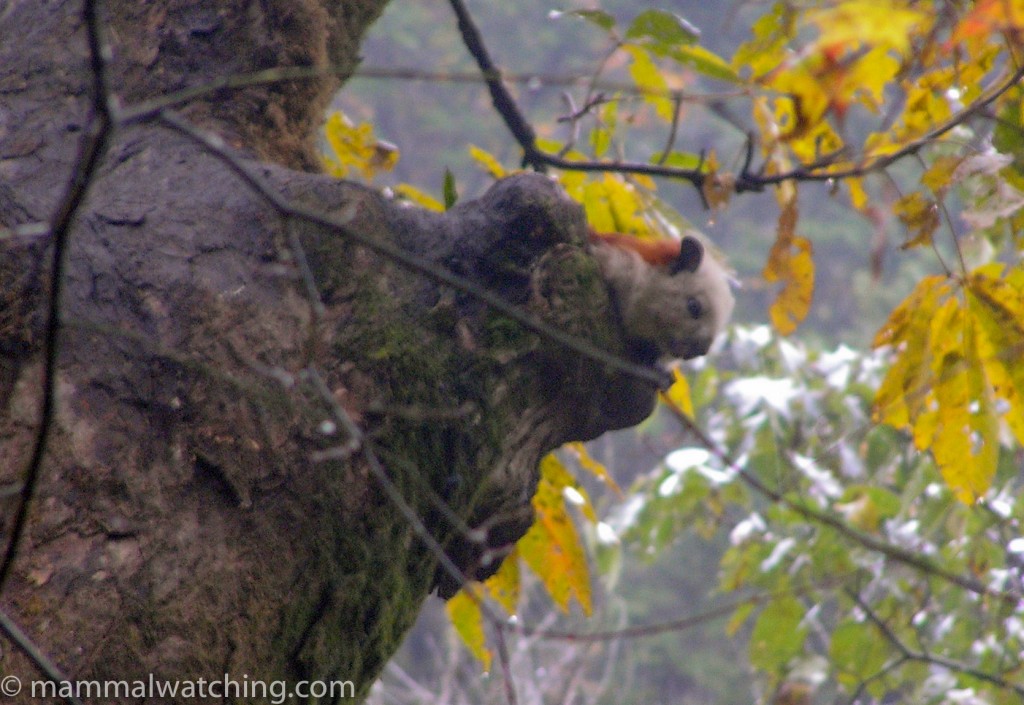
Red and White Giant Flying Squirrel, Petaurista alborufus
Later that afternoon Mr Zhang organized a celebratory feast, the sort reserved for festivals (and Australian mammal watchers). He killed a chicken, dusted off the best chopsticks and served up a dozen or so fabulous dishes along with lots of whisky.
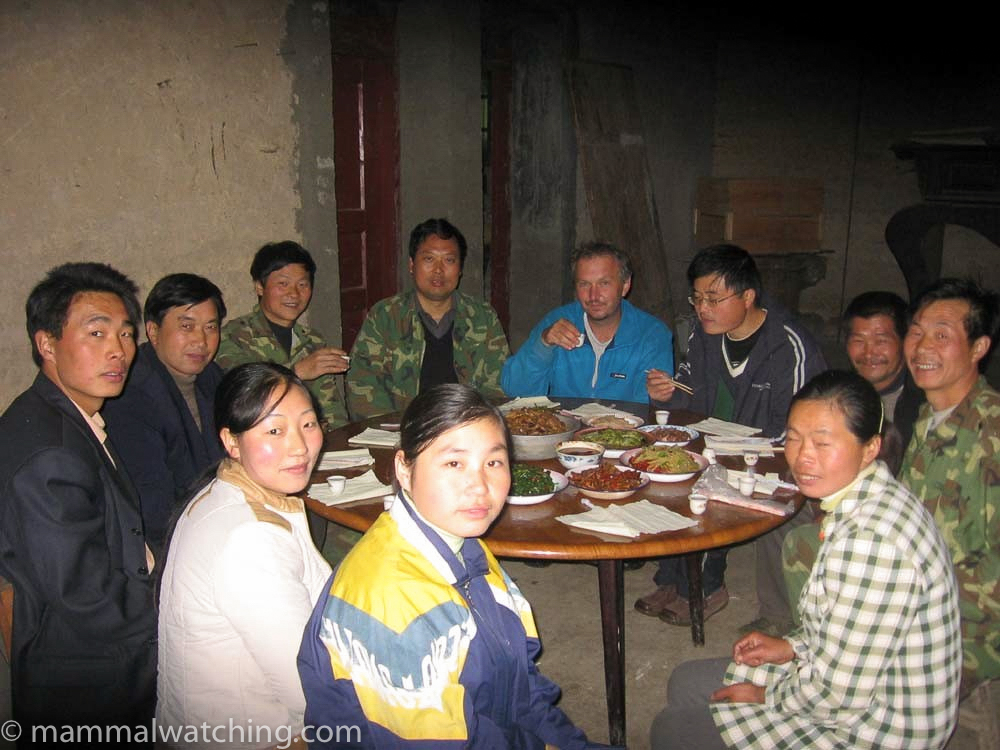
The festival of Jon
I went for a spotlight that evening alone, despite the dreadful warnings of danger from my interpreter. Though a solo spotlight seemed like a good idea in camp I began to change my mind as I considered what precisely I would do if I came on a Tiger (very very unlikely) or a startled 400kg of Golden Takin (not unlikely). About 1km from camp there was a crashing in the undergrowth. A Takin-like crashing (though quite possibly just Wild Boar). I didn’t stay around to find out. I didn’t quite run back to camp but my walk home was brisk to say the least.
Thursday 20/10
Crap weather again today so we went out again for a half-hearted hunt for Serow but were back in camp by 1 p.m. The rain cleared by dusk and I took a long last look at the scenery.
The forested mountains are awash with the colours of autumn and blanketed with a dozen different tree species. The wind is sending flocks of leaves high into the air, like parties of small birds that whirl through the sky. And I am cold. I’ve got a tee shirt, a polar fleece and my favourite hoodie on, plus a beanie. But still the wind whips into me. The chickens from the veggie garden behind the kitchen have broken loose. They are dashing around the grassy courtyard in a feeding frenzy, unable to believe their luck will last.
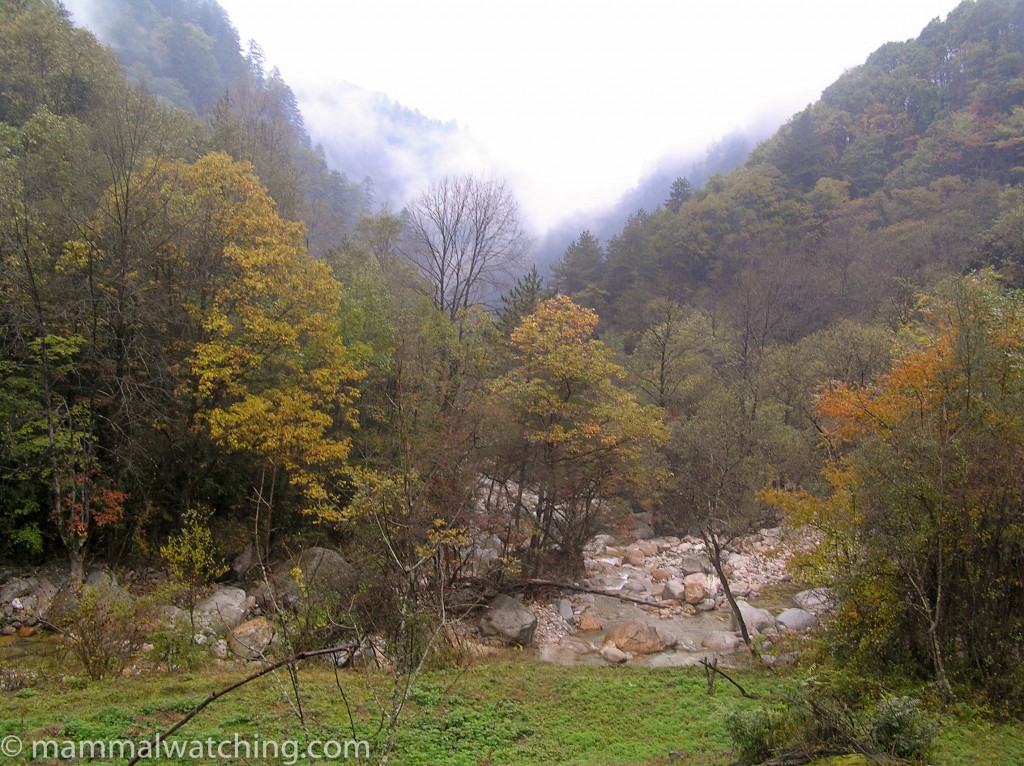
Foping Autumn
That evening I headed out for a 2 hour spotlight along the river. I saw very little, other than a rat until I was just 5 minutes from camp when I got some eye shine at the bottom of a cliff on the other side of the river. I got enough of a look at the animal to see it was a Serow: Serows are bogey beasts of mine, having eluded me on three trips to Thailand. So a nice way to end the trip.
Friday 21/10
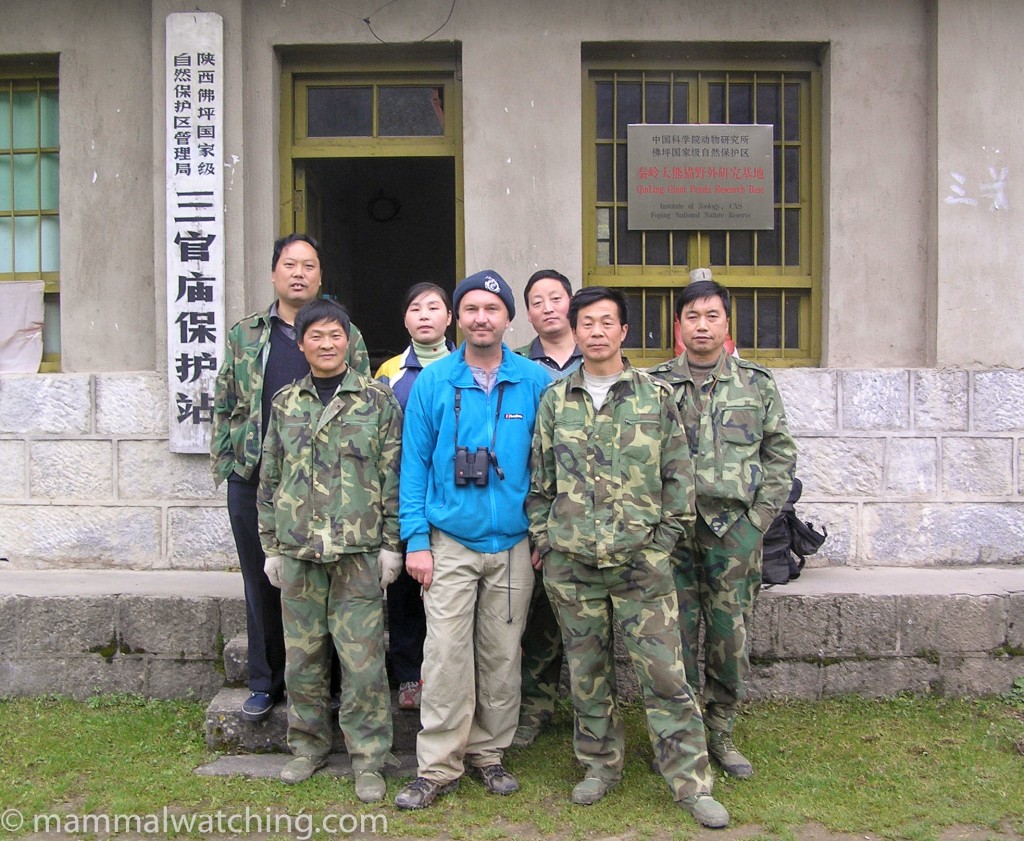
Me, with Mr Zhang on my left and Mr He on my right
After group photos and a leisurely breakfast I said goodbye to Sanguanmiao. A brisk 3 hour walk up to the top of the mountain and the waiting 4wd and then back for a last night at the Yangling Hotel. Never have I enjoyed a toilet more. The foot massage organized for me by Mr Li was pretty good too.
I spent Saturday looking at the Terracotta Warriors before catching a mid-afternoon flight back to Hong Kong. They are reputedly the 8th wonder of the world, though I have lost count of how many 8th wonders of the world I have seen. Interesting but not a patch on anything I saw in the mountains.
The Qinling Mountains are a remarkably unspoilt place, and long may they remain so. Beautiful, remote, with some very interesting and findable mammals and what must offer the best chance of seeing Giant Pandas anywhere. I can’t recommend it highly enough. (There are plenty of good birds too including Golden Pheasants and, if you got to the right spot, Crested Ibis).
Small Mammal Trapping
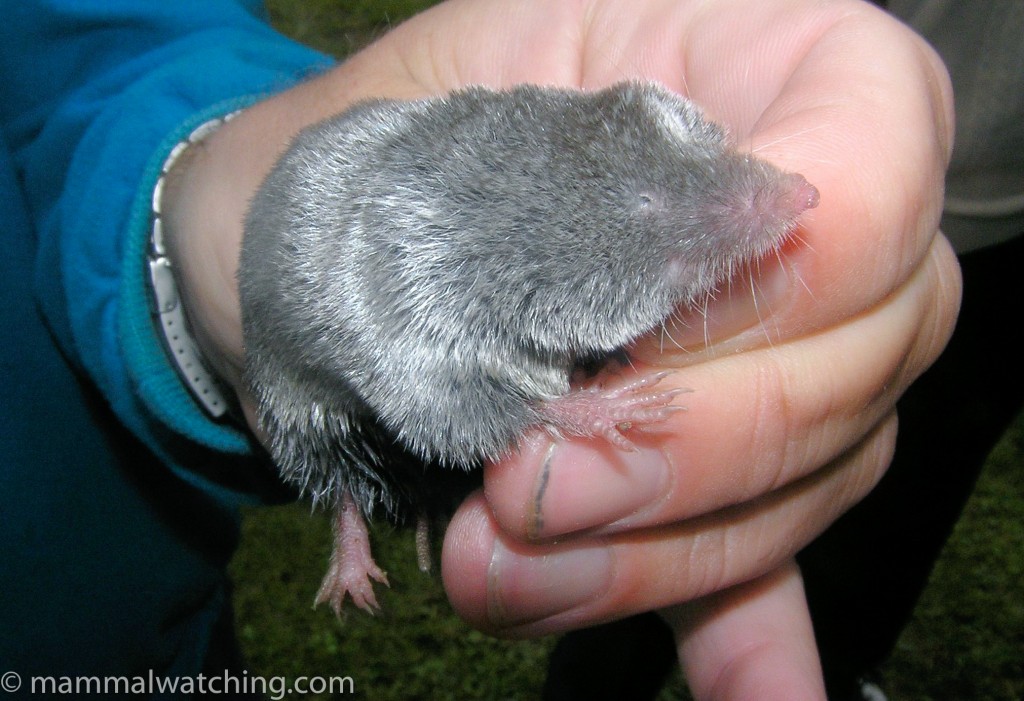
Chinese Mole Shrew, Anourosorex squamipes
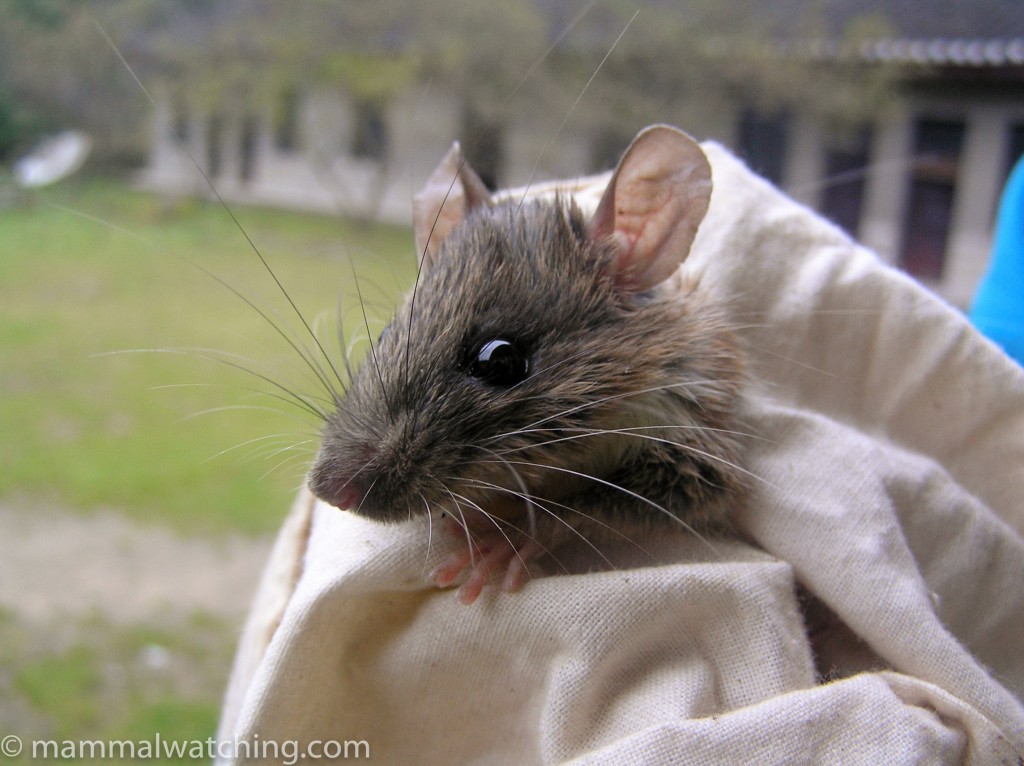
Confucian Niventer, Niviventer confucianus
I set small mammal (Elliott) traps in the forest each night and around the research station. There was a plentiful small mammal fauna with about a 70% trap success rate. Indeed, Mr Zhang set 4 traps one day and caught 5 animals (2 shrews in the one trap). The most commonly caught species were the chunky Chinese Mole Shrews (Anourosorex squamipes) and what I believe were Confucian Niventers (Niviventer confucians), both quite common in the grass around camp.
In the forest I caught a larger rodent which I thought was an Anderson’s Niventer but I learned later that that species is not found here: it was most likely a larger Confucian Niviventer. On my last morning I also caught a field mouse that seems to be Cheverier’s Field Mouse. We also caught one Eurasian Pygmy Shrew that died in the trap. I saw another three dead shrews along the trails after the rain on Wednesday and Thursday.
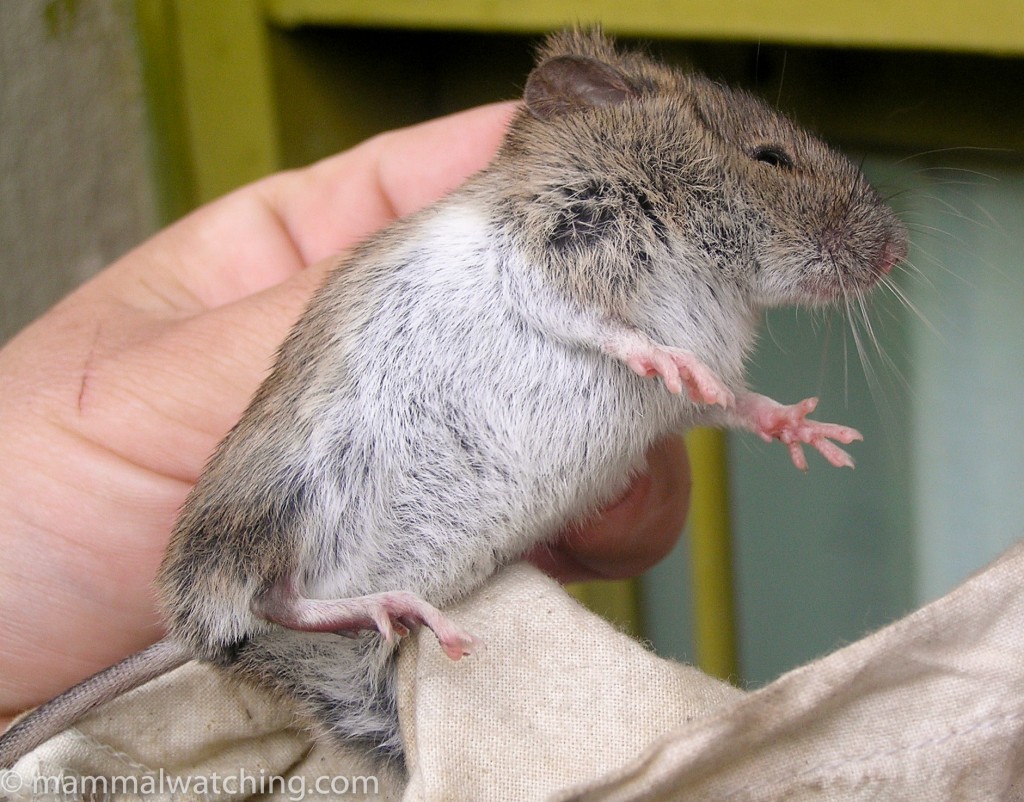
Chevrier’s Field Mouse, Apodemus chevrieri
Larger Mammals Seen
Golden Snub-nosed Monkey – one troop of about 20 animals seen on the first morning. I suspect the chances of finding these might be about 50% if you stay for a week. They aren’t common but you’ll hear them if they are within cooee.
Golden Takin – (Budocas tibetana bedfordii) – two separate sightings (one juvenile, and then three adults). Tracks were everywhere and they seem fairly common in the mountains. If you want to see one I imagine you’d be pretty likely to succeed in 2 or 3 days.
Eastern Gray Goral (Naemorhedus griseus) – reasonably easy to find I suspect if you focus on the right habitat (cliffs and scree slopes near mountain summits) but they are rather shy. We saw two on the first day.
Serow (Capricon sumatraensis) – again fairly widespread. Their latrine sites at cliff bases were quite common. That said, despite two half-days of intensive searching we couldn’t find the animals themselves (though the weather was a factor) and so they seem to be quite elusive. I saw one while spotlighting on the last evening.
Giant Panda – they are around and you have a reasonable chance of finding one (I’m guessing a 60% chance over a week’s worth of looking). We saw evidence of animals most days (Pandas must stop to crap every 10 metres I reckon). They are of course rather shy and sleep during the middle of the day. The best seasons for looking are reputedly late autumn and early spring (just before the first snow, and just as the snow is melting).
Red and White Giant Squirrel – ask the trackers to take you to the stag (hollow tree) about 45 minutes from camp where they will happily wake up one of these excellent beasts.
Pere David’s Rock Squirrel – fairly common, and seen every other day.
Swinhoe’s Striped Tree Squirrel – I saw a couple and they are probably quite common if more difficult to spot than the former species because they spend so much time up trees.
Stuff I Missed
The park list is enticing but from what I could work out there aren’t a great deal of other mammals that you have a reasonable hope of finding. Raccoon Dogs are present and are occasionally seen feeding on fruiting trees near the station in the right season. You’ve Buckley’s chance of finding Tigers or Red Pandas, though Asiatic Black Bears are possible (we saw tracks) and Leopards are a slim chance. Golden Cats are probably around but you’d have to be very lucky while there is the usual sort of chance of running into several mustelid species (Hog Badger, Chinese Ferret Bader, Yellow-necked Martin, Pygmy and Siberian Weasels). There is quite an extensive small mammal list but I am not sure how many of those animals are found around Sanguanmiao itself. Pere David’s Deer and Musk Deer are two interesting species that are apparently possible to find in winter, when they can be tracked through the snow.
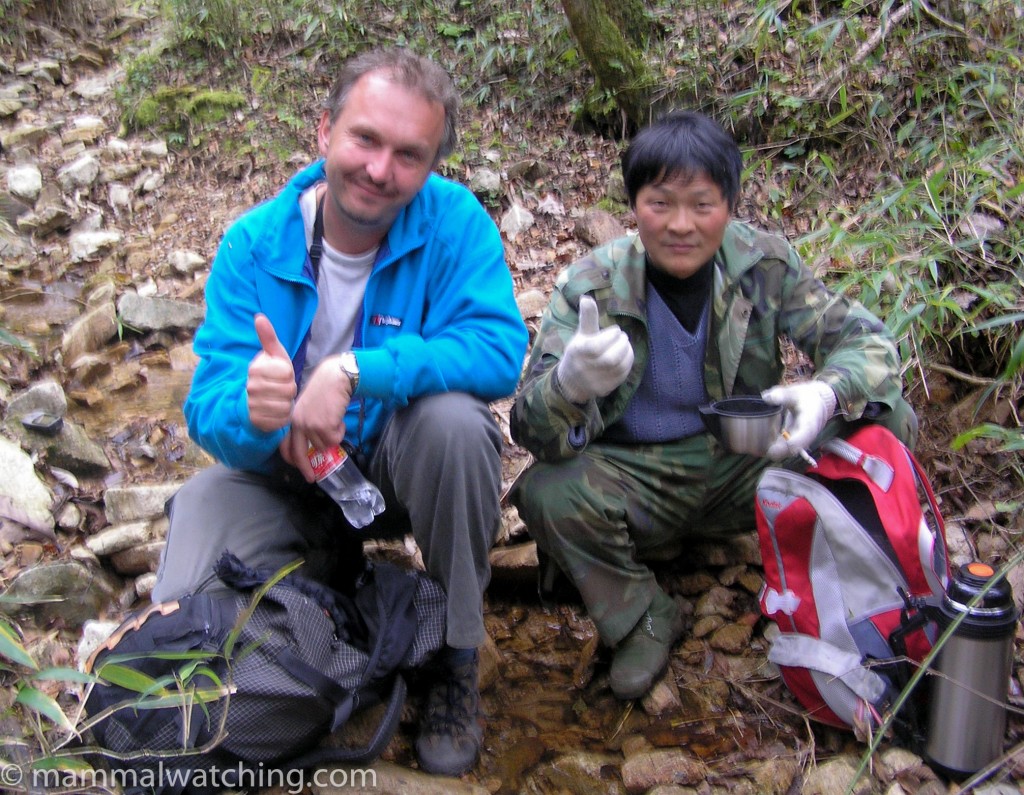
We just saw a Giant Panda!
2 Comments
Leave a Reply
You must be logged in to post a comment.


Natalia
Impressive. How can you contact with them now?